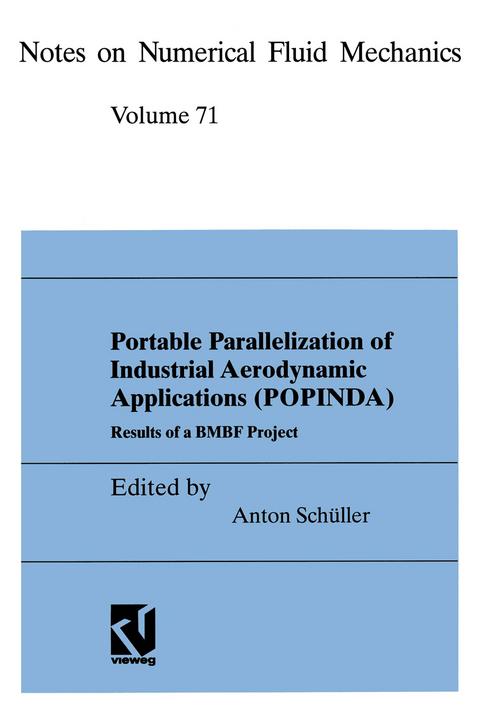
Portable Parallelization of Industrial Aerodynamic Applications (POPINDA)
Vieweg & Teubner (Verlag)
978-3-322-86578-6 (ISBN)
This book contains the main results of the German project POPINDA. It surveys the state of the art of industrial aerodynamic design simulations on parallel systems. POPINDA is an acronym for Portable Parallelization of Industrial Aerodynamic Applications. This project started in late 1993. The research and development work invested in POPINDA corresponds to about 12 scientists working full-time for the three and a half years of the project. POPINDA was funded by the German Federal Ministry for Education, Science, Research and Technology (BMBF). The central goals of POPINDA were to unify and parallelize the block-structured aerodynamic flow codes of the German aircraft industry and to develop new algorithmic approaches to improve the efficiency and robustness of these programs. The philosophy behind these goals is that challenging and important numerical appli cations such as the prediction of the 3D viscous flow around full aircraft in aerodynamic design can only be carried out successfully if the benefits of modern fast numerical solvers and parallel high performance computers are combined. This combination is a "conditio sine qua non" if more complex applications such as aerodynamic design optimization or fluid structure interaction problems have to be solved. When being solved in a standard industrial aerodynamic design process, such more complex applications even require a substantial further reduction of computing times. Parallel and vector computers on the one side and innovative numerical algorithms such as multigrid on the other have enabled impressive improvements in scientific computing in the last 15 years.
1 Overview.- 1.1 Basis, Goals and Results of POPINDA.- 1.2 POPINDA - the Industrial Qualification.- 2 Parallelization and Benchmarking.- 2.1 Unified Block Structures - the Basis for Parallelization.- 2.2 The High-Level Communications Library CLIC.- 2.3 Porting CLIC from PARMACS to MPI.- 2.4 FLOWer.- 2.5 NSFLEX-P.- 2.6 Benchmarks and Large Scale Examples.- 3 Algorithmic Aspects.- 3.1 Singularities of Block-Structured Meshes - a Special Parallelizable Approach.- 3.2 Dual-Time Stepping Method.- 3.3 Scalability of Parallel Multigrid.- 3.4 Convergence for Increasing Numbers of Blocks.- 3.5 New Smoothers for Higher Order Upwind Discretizations of Convection-Dominated Problems like the Euler Equations.- 3.6 Krylov Subspace Acceleration for Linear and Nonlinear Multigrid Schemes.- 3.7 Multiple Semi-Coarsening for 3D Singularly Perturbed Scalar Partial Differential Equations.- 4 Adaptive Local Refinements.- 4.1 Why to Use Adaptive Grids?.- 4.2 Self-Adaptive Local Refinements Supported by the CLIC-3D Library.- 4.3 Load-Balancing Strategies.- 4.4 Experiences LiSS.- 4.5 Experiences FLOWer.- 5 Special Aspects and Related Activities.- 5.1 Software Engineering and Software Quality Issues.- 5.2 Real Applications on Parallel Systems - the RAPS Initiative.- 5.3 MEGAFLOW.
| Erscheint lt. Verlag | 19.2.2012 |
|---|---|
| Reihe/Serie | Notes on Numerical Fluid Mechanics |
| Zusatzinfo | X, 223 p. |
| Verlagsort | Wiesbaden |
| Sprache | englisch |
| Maße | 155 x 235 mm |
| Gewicht | 364 g |
| Themenwelt | Mathematik / Informatik ► Mathematik ► Analysis |
| Naturwissenschaften ► Physik / Astronomie ► Mechanik | |
| Naturwissenschaften ► Physik / Astronomie ► Strömungsmechanik | |
| Technik ► Maschinenbau | |
| Schlagworte | computational fluid dynamics • Computer • convection • flow • fluid- and aerodynamics • fluid mechanics • Numerik • partial differential equation • Scientific Computing • Strömung • Strömungsmechanik |
| ISBN-10 | 3-322-86578-9 / 3322865789 |
| ISBN-13 | 978-3-322-86578-6 / 9783322865786 |
| Zustand | Neuware |
| Haben Sie eine Frage zum Produkt? |
aus dem Bereich


